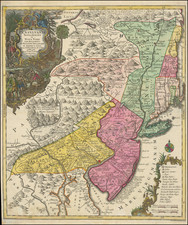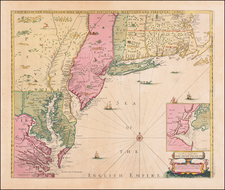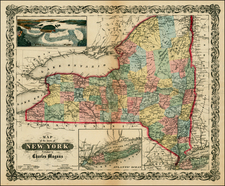A Dutch Maritime Chart of The East Coast of North America
Fine wide margined example of one of the finest and most beautiful regional 17th-century charts of America, from De Zee Atlas ofter Water-Weereld, first published by Goos in 1666.
This 1666 Dutch Sea Chart is an exquisite piece of cartography. The map vividly illustrates the Atlantic coast of America stretching from Cape Cod to Cape Hatteras, meticulously capturing the key geographical and colonial features of the mid-17th century.
At the heart of the map is the Dutch colony of New Netherland, reflecting the prominence of Dutch influence in the region during the era. New Amsterdam, which eventually transformed into present-day New York, is meticulously depicted at the tip of Manhattan Island, a testament to the colonial prowess of the Dutch.
Elsewhere, Dutch place names such as Staten Eylandt, Lange Eylandt, and Vlysingen (Flushing) pepper the map, a linguistic echo of Dutch presence in the New World. Along the Delaware River, a series of Dutch settlements such as Fort Casimir, Nassau, and Elsenburgh come into view, complemented by the Swedish Fort Christina. The Schuylkill River, future location of Philadelphia, is also distinctly marked.
Up north in New England, islands like Martha's Vineyard (Texel of Elisabets Eyl), Nantucket (Vlielandt of Natocke) and Block Island (Adriaen Blocks Eylandt) are shown , while early English named settlements, including New Plymouth, Crane Bay, London, etc. only begin to appear North of Cod. Further south, the Chesapeake Bay is delineated impressively with James Town rightly located. The Potomac River features as the Patwomeck, a snapshot of the evolving nomenclature of the region.
Dutch maritime trade in North America in the mid-17th Century is a central theme of this chart. New Netherland, including the settlement of New Amsterdam, was established as a result of this trade, primarily in fur, which attracted Dutch merchants and investors. The Dutch West India Company was at the forefront of this economic endeavor.
The creation of the chart during the Golden Age of Dutch cartography by the celebrated Pieter Goos adds immense historical and aesthetic value to this piece. The chart served not only as a tool for mariners but as a collector's item for the affluent merchant class. Notably, Goos' Zee-Atlas was the preferred marine atlas complement to Joan Blaeu's renowned terrestrial atlas, the Atlas Maior, underscoring the chart's significance and prestige.
Pieter Goos (ca. 1616-1675) was a Dutch map and chart maker, whose father, Abraham Goos (approx. 1590-1643), had already published numerous globes, land and sea maps together with Jodocus Hondius and Johannes Janssonius in Antwerp. Pieter gained recognition due to the publication of sea charts. He bought the copperplates of the famous guide book for sailors, De Lichtende Columne ofte Zeespiegel (Amsterdam 1644, 1649, 1650), from Anthonie Jacobsz. Goos published his own editions of this work in various languages, while adding his own maps. In 1666, he published his De Zee-Atlas ofte Water-Wereld, which is considered one of the best sea atlases of its time. Goos' sea charts came to dominate the Dutch market until the 1670s, when the Van Keulen family came to prominence.












![(18th-Century Southern Borderlands) [Collection of manuscript letters to Secretary of War James McHenry from confidential U.S. agent John McKee, relating to southern borderlands, Native Americans and Panton, Leslie & Co.; a letter from John McKee written from Mobile, Alabama, to William Blount of Blount's Conspiracy fame; a letter from William Panton concerning John McKee; and letters from Felix D. St. Hilaire, concerning General Victor Collot]](https://storage.googleapis.com/raremaps/img/small/90005.jpg)

![[ Large Cape Cod Inset ] The River & Gulf of St. Lawrence, Newfoundland, Nova Scotia, and The Banks Adjacent, From The English Admiralty & French Marine Surveys. . . . 1844. Additions To 1857.](https://storage.googleapis.com/raremaps/img/small/85637.jpg)